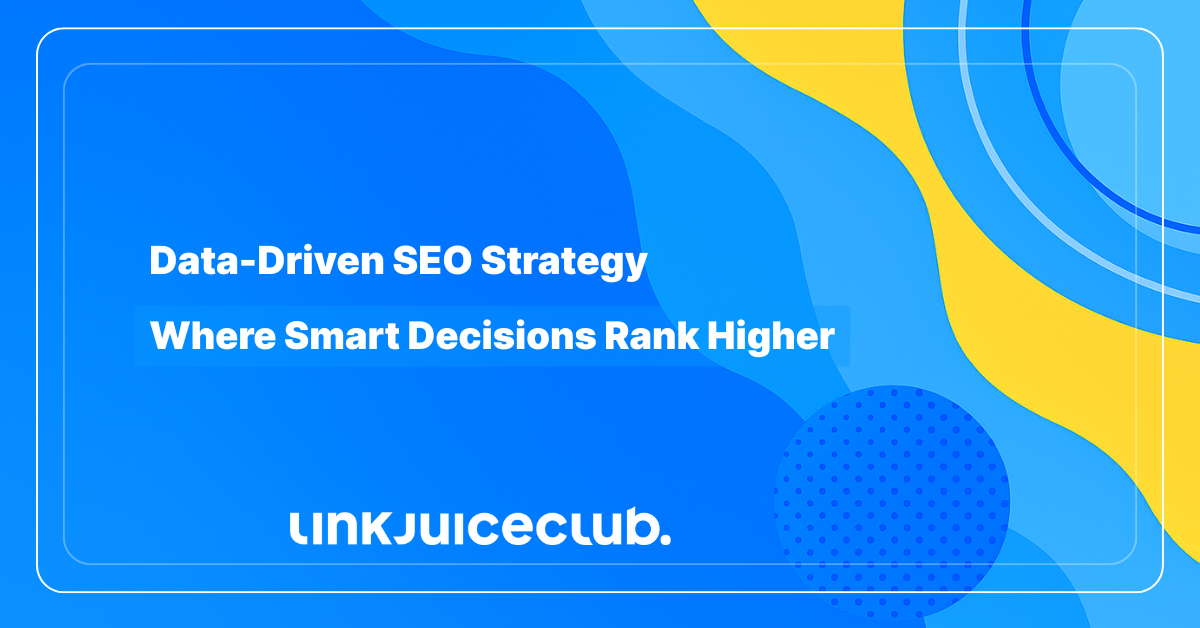
Data-Driven SEO Strategy: Where Smart Decisions Rank Higher
Trying to rank without data is like assembling IKEA furniture without instructions: confusing, frustrating, and you’ll probably end up with a three-legged bookshelf! A data-driven SEO strategy isn’t just the future – it’s the now!
In a digital world run by AI overlords (aka search engines), rankings shift by the hour, user behavior is unpredictable, and the only way to survive (and thrive) is by letting your data do the talking.
Whether you’re chasing traffic spikes, trying to crack Google’s code, or just want your blog posts to actually be read, a data-driven SEO strategy gives you clarity, direction, and real-deal results. 📈
Why Data Is the Real Boss of SEO
SEO is all about knowing what your audience actually wants and using that info to deliver content that hits the mark.

A proper data-driven SEO strategy digs into tools like Google Analytics and Search Console to see what real users are doing.
How long are they staying on your page? Are they clicking or bouncing? What keywords are bringing them in? That’s the gold.
This kind of insight helps you clean up what’s not working and double down on what is. You stop wasting time and energy, and you start getting results that matter.
Data Means Opportunities!
A data-driven SEO strategy points to new growth! Say a random blog post is suddenly getting traffic from a weird but specific search term. That should be your next big topic.
Or maybe you’re seeing traffic from a different country? Time to tweak your content for that market.
The point is: with data, you’re not just reacting. You’re planning. You’re building. You’re staying ahead of the game, while your competitors are still playing catch-up.
Here at Link Juice Club, we live for this stuff! If you’re ready to stop guessing and start using SEO strategies that are fueled by real insights, we’ve got your back.
From Numbers to Aha! Moments: Making Data Actually Work for You
Raw SEO data isn’t helpful unless you know what the heck to do with it. Clicking around dashboards without a clear goal is confusing and unproductive!
Here’s how to stop spinning your wheels and start transforming data into actual, useful insights that drive your data-driven SEO strategy forward.
1. Ask Smart Questions!
Before you pull open 37 tabs and fire up five SEO tools, take a moment to breathe and ask yourself: What am I trying to solve? Are you chasing more organic traffic? Trying to understand a sudden traffic drop?
Getting clarity here means you’ll only chase down the metrics that matter. It saves time, sanity, and helps you stay laser-focused on solving real problems, not phantom issues.
2. Pull the Data That Actually Matters
Once your question is clear, it’s time to wrangle the right data. Whether you’re poking around in Ahrefs or spelunking through Search Console, collect the exact metrics tied to your question.
For example: if a product page is underperforming, focus on session duration, engagement rate, click-through rate, and maybe even scroll depth. Simply put, hunt for clues!
This step is the muscle of your SEO strategy; it gives you the raw power to make big decisions.
3. Detect Patterns Like a Trend-Sniffing Bloodhound
Now that you’ve got a pile of juicy metrics, it’s time to spot the story they’re telling. Are certain topics getting attention but not converting? Is one page loading slower than your grandma’s dial-up and bleeding visitors?
This is where the lightbulbs start flashing. Maybe your titles are killer but the content fizzles. Maybe users in Germany are loving your guides, while folks in Canada bounce in 3 seconds.
That’s segmentation magic – find who’s doing what, where, and why.
Patterns equal power. They let you fix what’s broken and double down on what’s working.
4. From Numbers to Next Moves
All that analysis? It’s useless unless it turns into action. That slow-loading article? Compress those images and ditch that bloated plugin.
That high-traffic blog post with zero conversions? It’s time for a stronger CTA or a search-intent makeover.
This final step is what makes your SEO strategy more than a report; it makes it a roadmap. You’re not just looking at numbers anymore. You’re making moves.
Where Data-Driven SEO Strategies Are Born
Want to squeeze brilliant insights from your SEO data? First, you need the right toolbox. Not just any toolbox, but one loaded with sharp, savvy instruments that go beyond basic vanity metrics.
💥 GA4 & Search Console: Your SEO Crystal Ball
Google Analytics 4 (GA4) and Google Search Console are your ride-or-die duo.
GA4 gives you a live pulse on how users interact with your site: where they came from, how long they hung around, what made them bounce, or what got them clicking.
Meanwhile, Search Console tells you how your content is behaving in the wild west of Google SERPs. Are your pages being crawled properly? Are you accidentally de-indexing a masterpiece? Are users even clicking your juicy titles? This is where you find out.
Together, GA4 and GSC lay the foundation of your data-driven SEO strategy, helping you answer the big question: What’s working, and what’s not?
💥 Zooming In: User Behavior Tools That Show the Whole Picture
Numbers are great, but sometimes you need to see the humans behind the stats. That’s where behavior analysis tools like Hotjar and Microsoft Clarity enter the chat.
These platforms show you how people move around your site in real-time.
Scroll maps, rage clicks, exit points – it’s like watching over your users’ shoulders without being creepy. Pair these behavioral insights with your analytics data, and you’ve got the full narrative.
Advanced Data Tricks for Next-Level SEO
Alright, you’ve mastered the basics, now let’s dive into the nerdier (read: juicier) side of a data-driven SEO strategy. This is where the pros play. These techniques go beyond traffic reports and into the realm of rich, strategic insight.
Let’s Talk Segmentation: Because Not All Visitors Are Created Equal
Tossing all your site data into one giant pile? Rookie move. Segmenting your audience helps you see who’s doing what (and why). Break your traffic down by location, device type, age group, or even behavior patterns.
And suddenly, things get clear.
Let’s say your desktop users are smashing the engagement metrics, but mobile users are bouncing incredibly fast. That’s a red flag you wouldn’t catch without segmentation. This technique helps you pinpoint UX hiccups, content misfires, and all those sneaky little conversion killers hiding beneath the surface.
Trends Over Time: Ditch the Daily Drama
Looking at one-day dips is like judging a movie based on its trailer, pointless and often misleading.
Instead, zoom out. Monthly, quarterly, or even year-over-year trend analysis gives you the full picture.
Is your organic traffic steadily climbing? Great. Did last month’s algorithm update send your rankings into a tailspin? Even better, you caught it early. This kind of long-view thinking turns knee-jerk panic into data-powered poise.
Big Data, Big Moves: Harnessing Scale for Smarter Strategy
Think of big data as the SEO version of a high-powered telescope. While regular analytics tools show you a slice of behavior, big data uncovers patterns across huge datasets (user intent, seasonal surges, or microtrends across industries).
Build Dashboards That Talk Back
Tired of juggling a dozen tabs and endless CSV exports? It’s time to build dashboards that do the thinking for you.
Tools like Looker Studio let you fuse data from Google Analytics, Search Console, Ahrefs, Semrush (you name it) into one clear visual command center.
Want to show your team exactly why conversions tanked last week? Or how a content tweak turned bounce rates into bookmark stats? A good dashboard speaks louder than a PowerPoint ever could.
And yes, it’s also perfect for impressing your boss during Monday meetings.
SEO Is A Long-Term Relationship That You Need to Nourish
If you think SEO is a set it and forget it kind of deal, you’re gonna have a bad time. A real data-driven SEO strategy is all about consistency, refinement, and evolution. The only way to stay ahead? Iterate like a maniac and report like a pro.

Build Your SEO Gym Routine
Think of data check-ins like a fitness plan for your site. You wouldn’t hit the gym once and expect a six-pack, right? The same goes for SEO.
Daily checkups help you catch red flags early. Weekly reviews keep your short-term tactics on track. And monthly or quarterly deep-dives? That’s where you spot juicy long-term trends that others miss.
Tinker, Test, Repeat: The Science of SEO Wins
Got a sneaky hunch that a new CTA could boost clicks? Don’t just cross your fingers, run an experiment.
A/B test your layouts, play with your metadata, try different content formats. Test weird ideas. Break things on purpose. Every test (even the ones that flop) feeds your strategy with real data. That’s how you level up!
Close the Loop or Stay in the Dark
Once you’ve made changes, go back and measure the results. Did your bounce rate drop? Are your pages climbing the rankings?
If yes, bake that tactic into your playbook. If not? Tweak it and try again.
This feedback cycle is what makes your strategy adaptive, scalable, and better than 90% of what your competitors are doing.
The Smart Way to Build a Data-Driven SEO Strategy
A truly effective data-driven SEO strategy starts with smart questions. When you ask the right questions, collect focused data, and analyze it through a strategic lens, you unlock the kind of insights that make your rankings climb like they’ve had five espresso shots!
The experts at Link Juice Club recommend anchoring your SEO efforts in this kind of data-fueled thinking. Stick to these principles, keep iterating, and you’ll have a content strategy that delivers, day after day, update after update. 🚀





